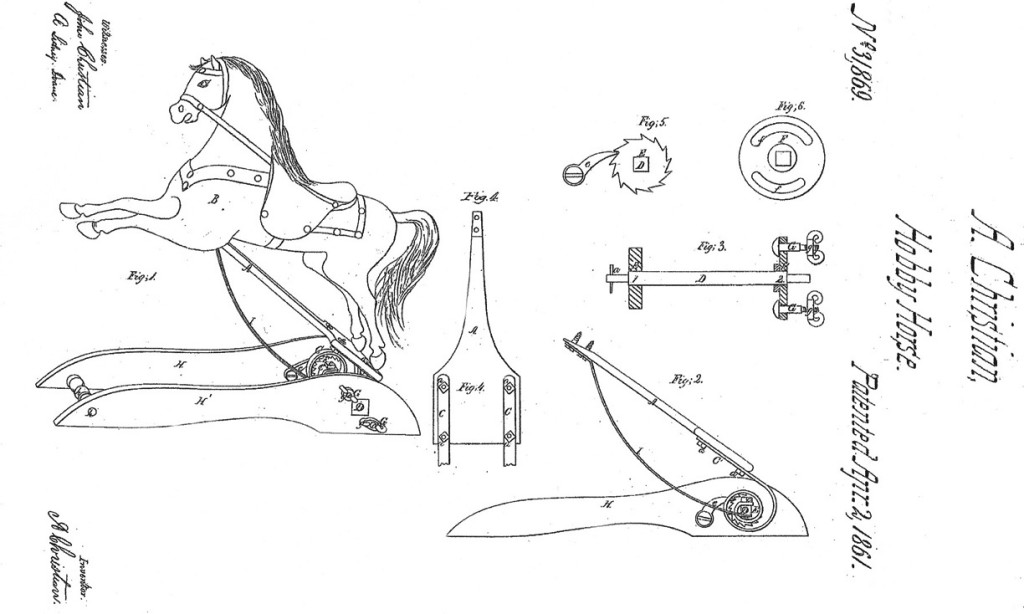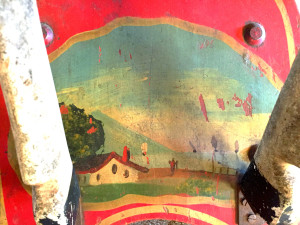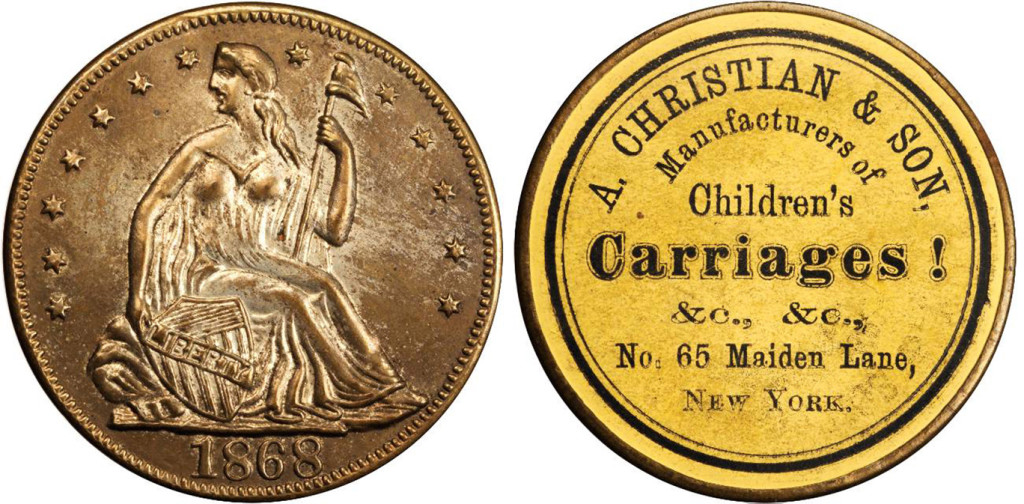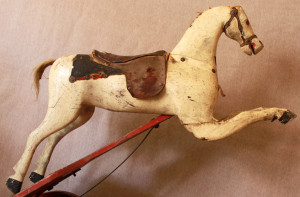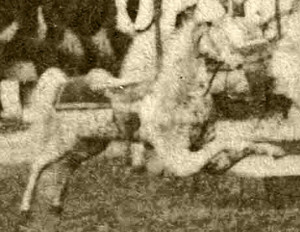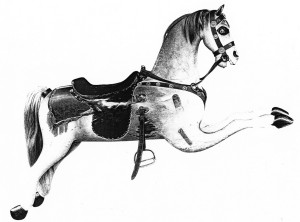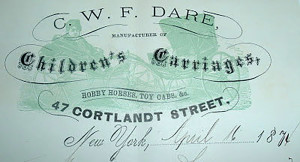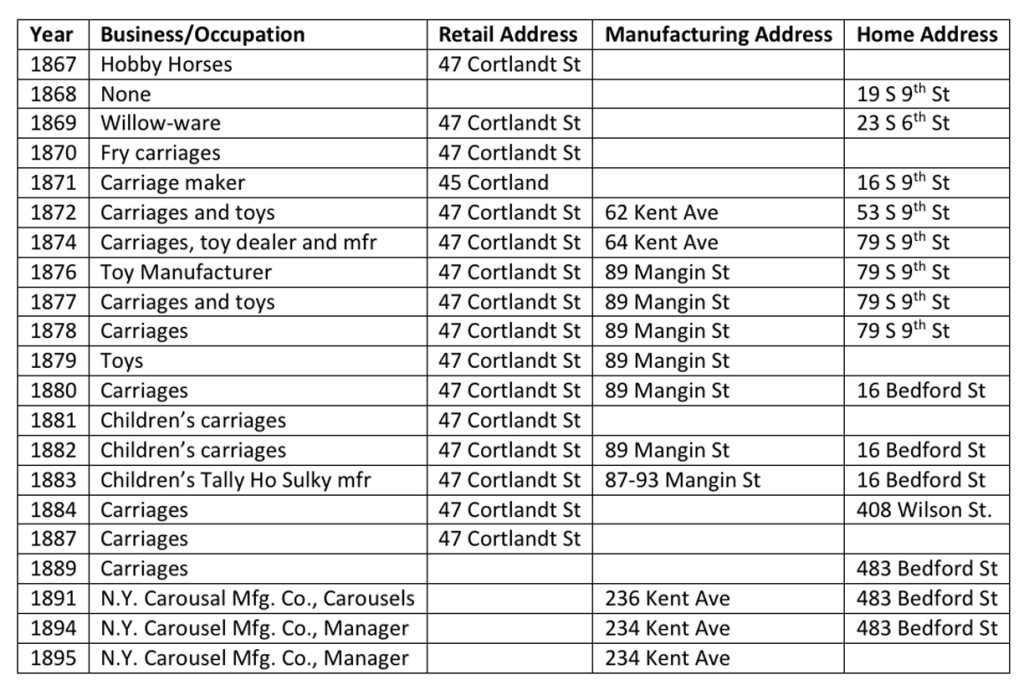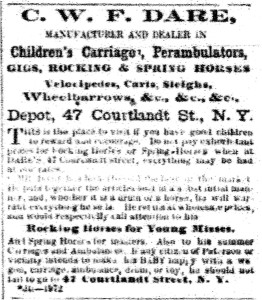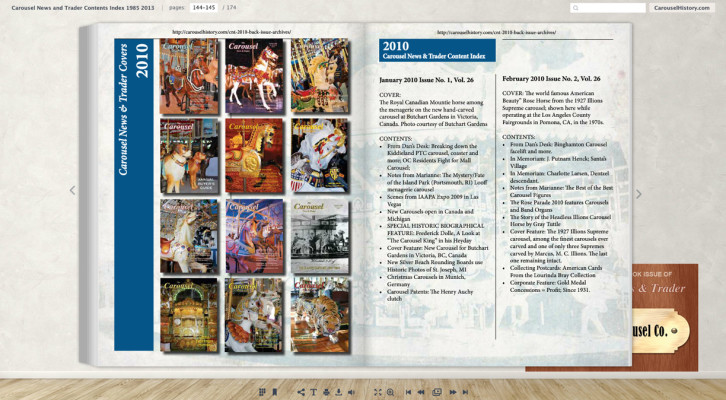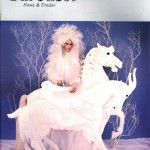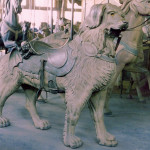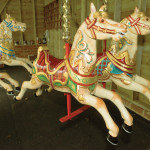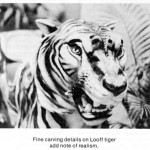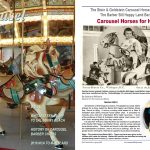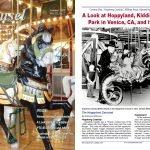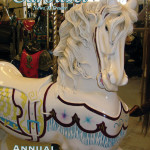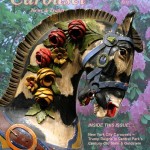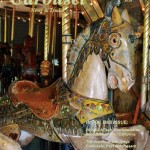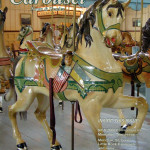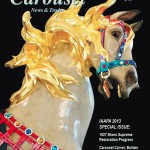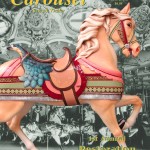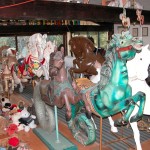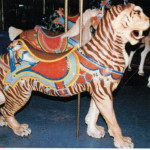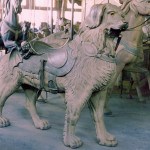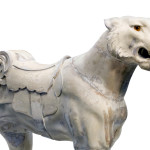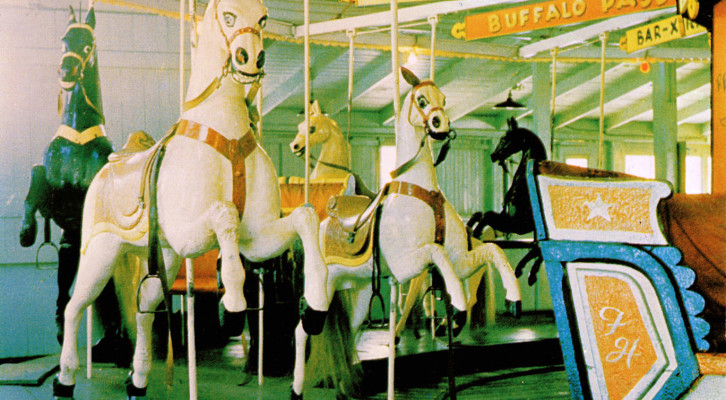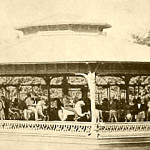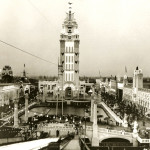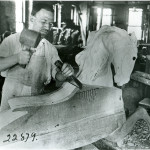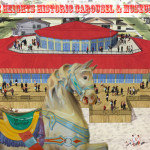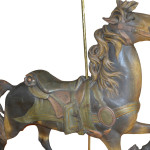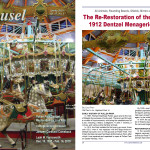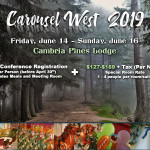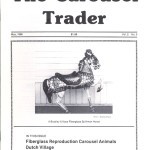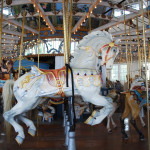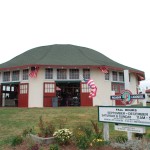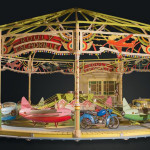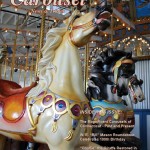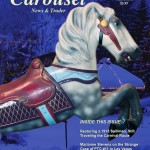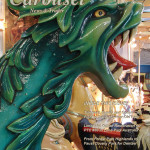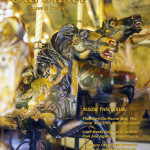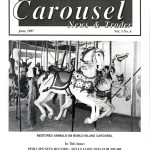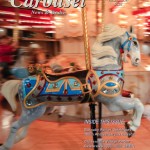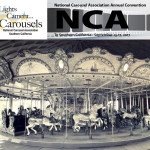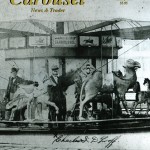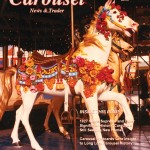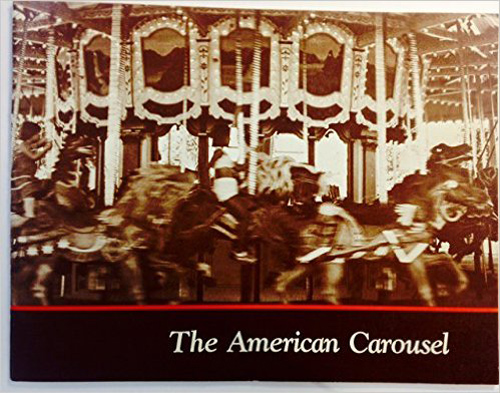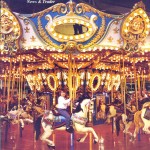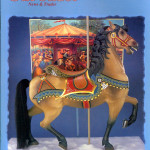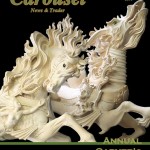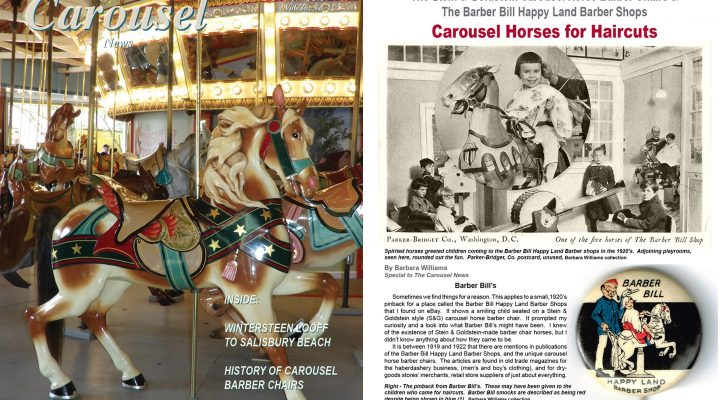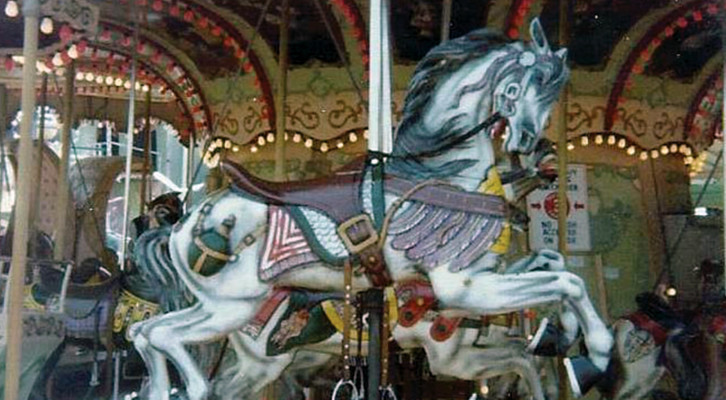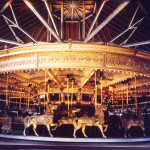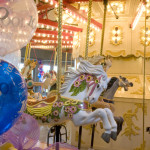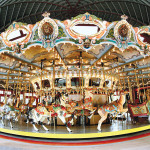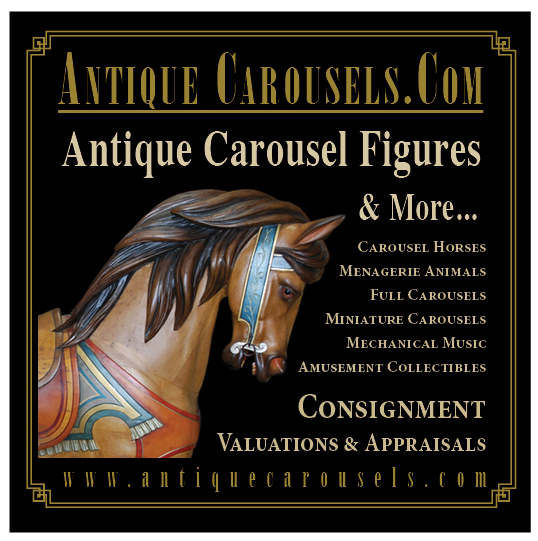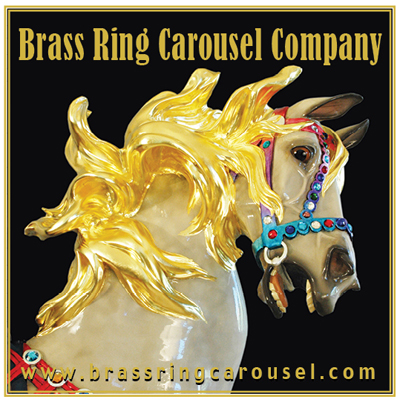PART 1 PART 2 PART 3
Carousel History Feature – American Carousel Pioneers – Andrew Christian and Charles Dare
A Fresh Look at Andrew Christian and Charles W.F. Dare – Their Early Toy Manufacturing Careers and the Development of the Country Fair Carousel Style
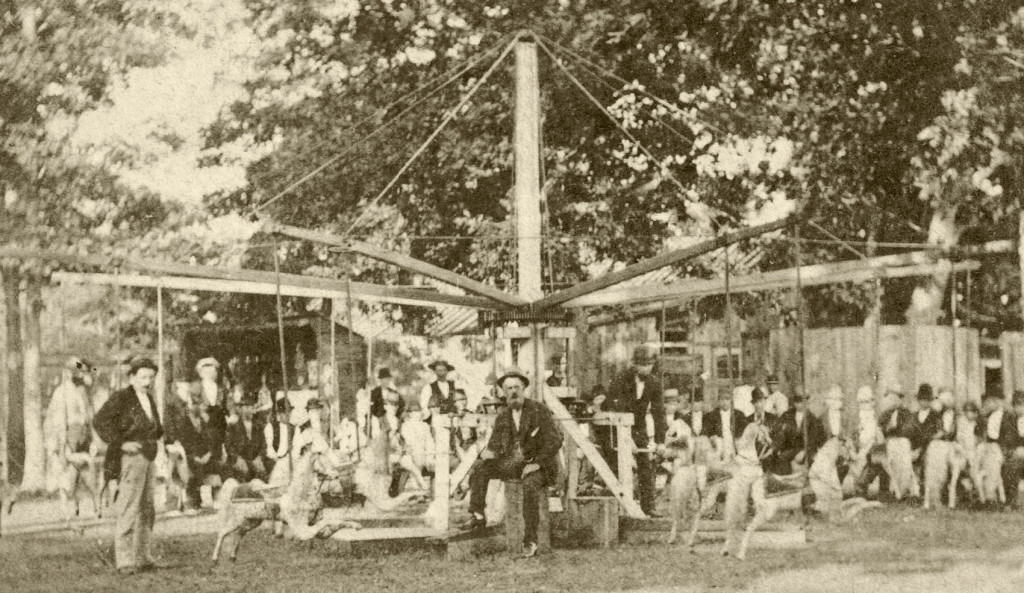
Undated stereo image of a hand-powered carousel similar to Watch Hill’s carousel, Westerly, Rhode Island. All of the figures are in the style of Andrew Christian, a hobby horse manufacturer. Barbara Williams collection.
Part 1 of 3…
Contributed by William Benjamin, Ph.D., and Barbara Williams
Bill recently had the opportunity to purchase a circa 1860’s Andrew Christian “Improved Rocking Horse”. The horse was found at the Nashville Antique Archeology store which is run by the hosts of the History Channel television series, American Pickers. Quite amazingly, the horse and stand were still in original paint and the horse had remnants of many of its original leather trappings. While researching the history of the rocking horse, we came across an intriguing comment in the December 2008 issue of The Carousel News and Trader in an article about the Watch Hill, Westerly, Rhode Island carousel. (1) The author pointed out the similarity of that carousel’s horses to those found on Christian’s rocking horses and further claimed that Christian and Dare worked together.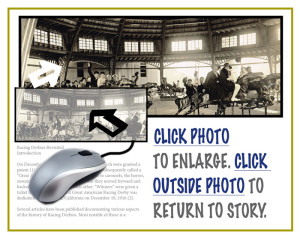
For this article, we decided to take a fresh look at the early toy manufacturing businesses of Andrew Christian and Charles Dare, examine the evidence supporting their possible business relationship, and elucidate as accurately as possible the evolution of Dare’s carousels. During the course of this research we came upon other articles addressing some of these topics to various extents. We reference these articles as appropriate, but in cases where the dates in them are not supported by documentation, we don’t use the dates as factual.
Andrew Christian
According to his 1870 United States census record, Andrew Christian was born in about 1825. He lived in Fordham, Westchester, New York, with his wife and son. Christian began his toy manufacturing and retail business in 1856. (2) The variety of items manufactured by Christian can be discerned from his United States patent history, New York City Directories, advertisements, and newspaper articles.
Christian received a total of six patents in the 1860’s relating to children’s toys.
No. 31,869 dated April 2, 1861. Improved Rocking Horse. This patent describes the spring mechanism on the country fair style Improved Rocking Horse
No. 54,111 dated April 24, 1866. Improvement in Childs Carriage No. 81,603 dated September 1, 1868.
No. 87,245 dated February 2, 1869 and No. 95,515 dated October 5, 1869. Improvement in Velocipedes
No. 83,363 dated October 27, 1868. Improved Folding Perambulator (baby carriage)
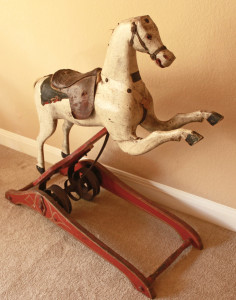
Circa 1860’s Andrew Christian’s “Improved Rocking Horse” with original paint and remnants of original trappings, obtained from the Nashville Antique Archeology store. The patented improvement was the scroll spring mechanism controlled by a ratchet. This mechanism was intended to replace bow rockers that were used up to this time and were prone to tipping over. William Benjamin collection
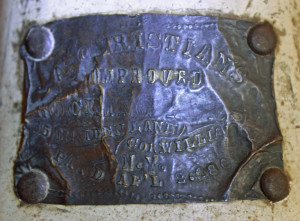
Brass patent plate on the Christian rocking horse. The plate reads “A. Christian’s Improved Rocking Horse. 65 Maiden Lane cor. Williams St. N.Y. Pat’d Ap’l 2, 1861”.
Most of the references to Andrew Christian’s company refer to it as Andrew Christian & Son. (3,4) The 1868 Brooklyn City Directory lists his store location at 81 Maiden Lane (under the heading “Toys”). The 1869 and 1871 Brooklyn City Directories under the headings, “Toys” and “Hobby Horses”, respectively, list his store’s location at 65 Maiden Lane, Brooklyn, New York, the same address as shown on the rocking horse brass patent plate. The 1870 New York State Business Directory lists him as “Manufacturer of Christian’s patent spring horses, perambulators, carriages, cabs, rocking horses, propellers, sleighs…” An article in the October 3, 1866 issue of The New York Times (5) mentions a fire at his manufacturing buildings. “Fire discovered at three-story brick buildings known as Nos. 87 and 89 Mangin Street owned and occupied by Andrew Christian, manufacturer of hobby horses and children’s fancy carriages. Damage to stock and machinery estimated at $60,000-90,000 and covered by insurance.”
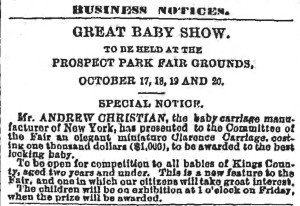
Andrew Christian passed away due to injuries incurred while returning home after awarding the baby carriage at the show on October 20, 1871. The Brooklyn Daily Eagle, October 19, 1871.
Andrew Christian met a tragic death from an accident on the evening of October 20, 1871. He had been attending a fair in Prospect Park, New York City, where he awarded one of his baby carriages valued at $1000 as a prize in a baby contest. On the way home to Fordham, and while still in the park, his carriage hit a curb and he was thrown off, hitting his head on the ground. He died the next day. (6, 7,8) In a strange twist of fate, his wife, Emma, died on May 9, 1872 when thrown from a trolley car while taking her two young sons to Christian’s grave site at Calvary Cemetery. (9)
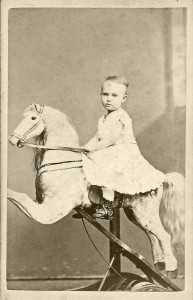
1870’s CDV printed by Suppards and Fennemore, No. 820 Arch Street, Philadelphia of a high end calfskin-covered Christian improved spring rocking horse. William Benjamin collection.
The Continuation of Christian’s Business
A firm by the name of Hoffmire, Kelsey & Cornwell assumed control of Christian’s business. They continued using the retail store established by Christian at the 65 Maiden Lane address. Hoffmire, et al. priced the Christian spring rocking horses from $8.50 to $50.00. The upper price range was for rocking horses with, “calfskin, glass eyes, leather harness and hand painting on the spring base”. (2) Note in the advertisements (below) that the company is shown continuing to occupy manufacturing sites at 87, 89, 91 and 93 Mangin Street. We found a subsequent reference to Hoffmire et al. at 65 Maiden Lane in GOULDING’S BUSINESS DIRECTORY, for the period ending May 1, 1875. This is the last reference we found for the Hoffmire et al. firm running the Christian business and this date coincides with the initial use of the Mangin manufacturing buildings by Charles W.F. Dare (see below).
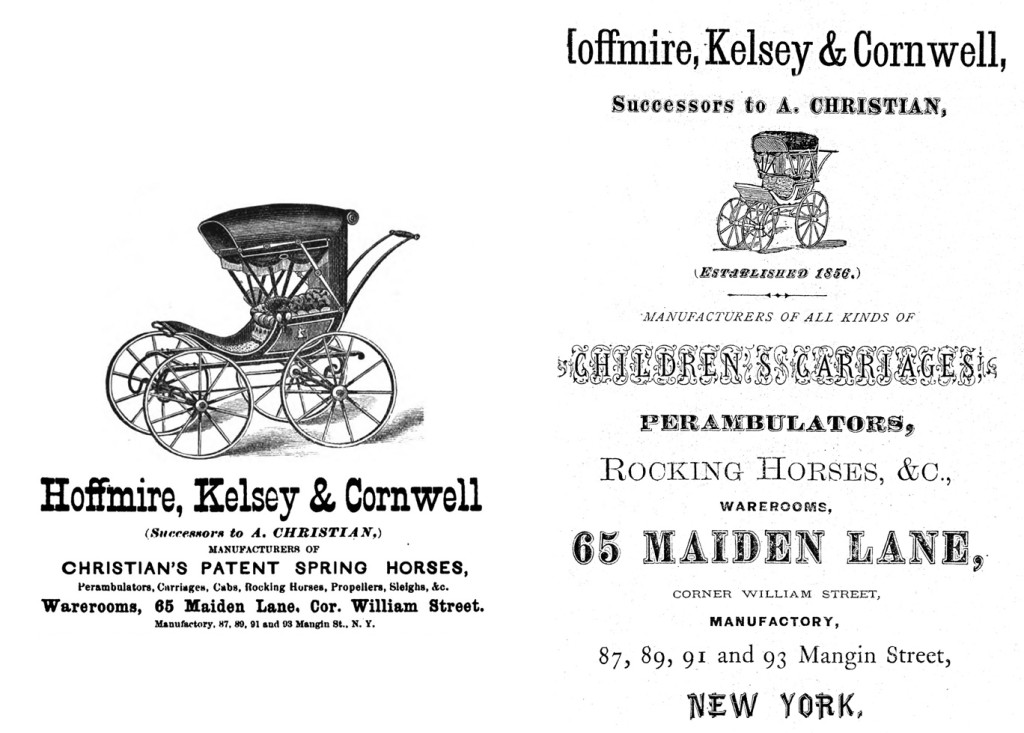
Left. Hoffmire, Kelsey & Cornwell took over management of Andrew Christian’s firm following his death in 1871. From April 2-9, 1873 Minutes of the Twenty Fifth Session of the New York East Annual Conference of the Methodist Episcopal Church. Right. Advertisement from the Fred and Mary Fried Archive, Smithsonian Institution.
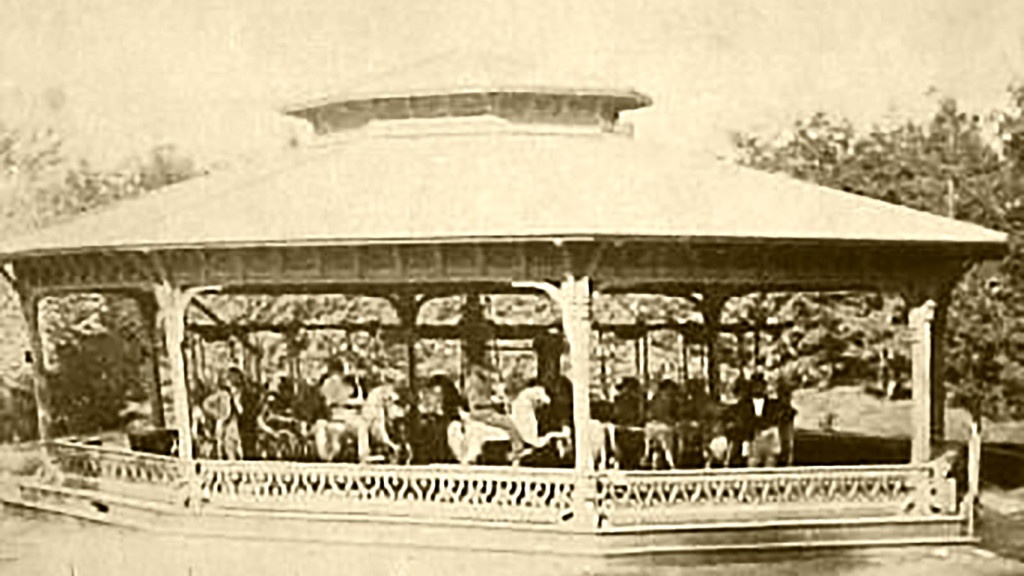
Early stereo view image of the Central Park Carousel by Aaron Veeder, Albany, New York with horses that have the signature elevated Christian foreleg angle. A modified image from WorthPoint.
1871 – Central Park’s Carousel
A carousel was ordered for Central Park on June 6, 1870. (10) By 1873, the carousel had been relocated from its original spot to a new location and Hoffmire, Kelsey and Cornwell had been contracted for work “amounting to $170, for repairing twenty hobby-horses of the Carrousel”. (11) This is the first mention we have found of a possible association of Christian’s firm with a carousel. The horses on the carousel are clearly the Christian-style, further confirming involvement.
So, two years after Christian’s death in 1871, his company’s successor is called upon for carousel repairs and by 1876, as shown later, Dare has assumed occupancy of the Christian/Hoffmire, et al. manufacturing facilities.
1874 – A Carousel for Prospect Park, Queens, New York
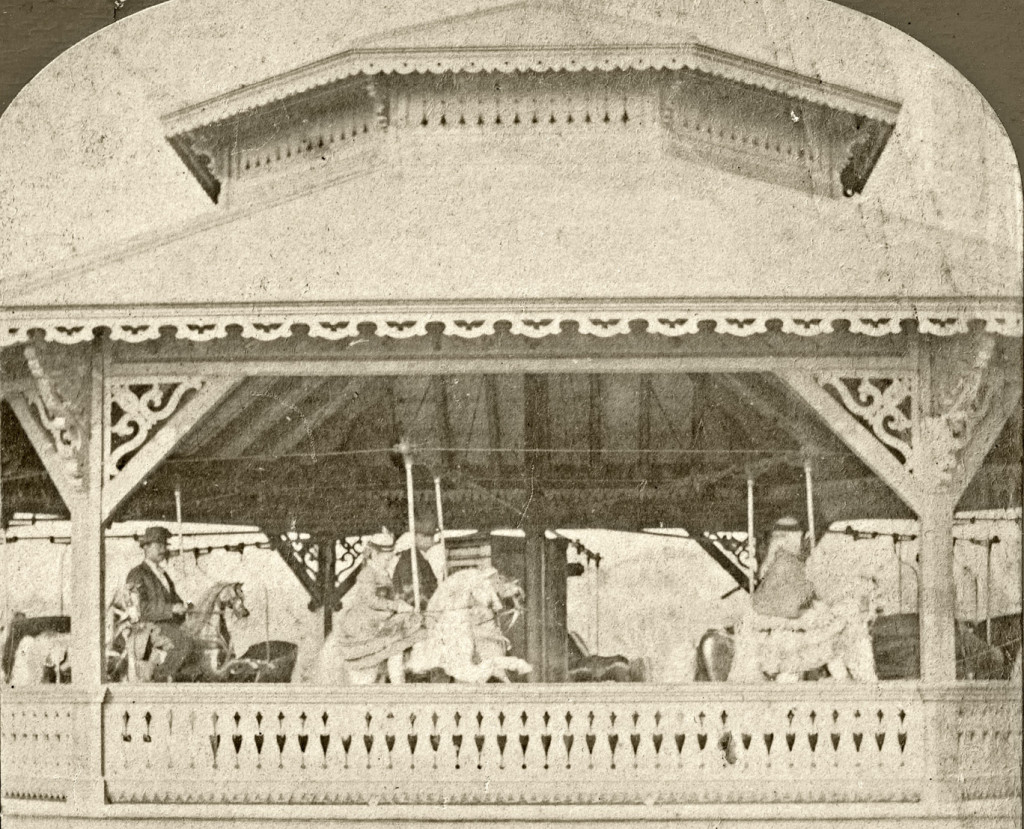
Undated stereoview of the Prospect Park carousel showing Christian-style raised front legs on the horses, center and left. The horse on the right does not have elevated front legs. This carousel, as well as Central Park’s, may also have become a hybrid by the date of these photographs, with two styles of horses showing. Barbara Williams collection
In 1874, a new carousel was installed at Prospect Park. The enlargement of the stereo shows prototypical Christian horses with the elevated forelegs. Since it appears that this carousel was built almost three years after Christian’s death in 1871, it is very possible that they were supplied by Christian’s successors, Hoffmire, et al.
We don’t know who built the very early Central and Prospect Park carousels. Both are populated with Christian-style horses and the Prospect Park carousel had more than one larger, stationary horse of unknown origin. Since the original Prospect Park carousel is described as having suspended horses (12), was the carousel modified at a later date to accommodate stationary horses and, if so, by whom?
Origin of the Horse Style Associated with Several Early Carousels
A key question is: how can one distinguish Christian-style horses from horses that could have been made by many of the other hobby horse/rocking horse manufacturers of the time? Prior to the invention of the “spring rocking horse” mechanism, rocking horses were mounted on bow rockers, which required the front and back legs of the horses to angle downward.
The upward position of the spring mechanism allowed the front legs of the horse to project in a more horizontal direction in contrast to previous bow rockers. An evaluation of the horses mounted on the spring rocking horse mechanisms patented in the United States in the 1860’s, including those of Christian (1861), Crandall (1861 and 1862), Reinhart (1863), Metzler (1865), and Brown (1866), can be made from illustrations and examples in the book about rocking horses by Patricia Mullins (2). This analysis shows that only Christian spring rocking horses exhibit the unique characteristic of the angle of the front legs being horizontally elevated higher than the line defined by the bottom of the “belly”. We subsequently refer to this as the “Christian foreleg angle”. This Christian foreleg angle provides a fingerprint that allows for the identification of other early carousels that are populated with Christian-style horses. Below is a comparison of the profiles from the example of the Christian spring rocking horse that was purchased from Antique Archeology, an enlarged cropped image from the early carousel shown at the opening of the article and an image of a horse from the Watch Hill, Westerly, Rhode Island carousel.
- Christian’s “Improved Spring Rocking Horse”. William Benjamin collection
- Detail from the early carousel image at the opening of the article. Barbara Williams collection
- Watch Hill, Westerly, Rhode Island horse. Note the almost identical form of the carvings. A consistent characteristic of these figures is that the angle of the forelegs projects horizontally above the line defined by the bottom of the belly (“Christian foreleg angle”). Fred and Mary Fried Archive, American History Museum, Smithsonian
- C.W.F. Dare letterhead dated April 16, 1874. From Ancestry.com
Charles W.F. Dare
Charles W.F. Dare was born on June 18, 1834. (13) His father, also named Charles W.F. Dare, was a shoemaker, who quite interestingly owned a business at 157 Maiden Lane, not far from Andrew Christian’s store. Dare was appointed postmaster at Seldon, Suffolk, New York, on December 9, 1856. C.W.F Dare, Jr was listed as a new arrival at the Belmont Hotel in the April 2, 1859 New York Evening News and in an article in the April 14, 1878 Brooklyn Eagle it is stated that he had been in business in New York since 1859 so it seems quite possible that he began his toy business at that time. Another 1878 newspaper article mentions that he had been in the carriage manufacturing business for 20 years. (14)
C. W. F. Dare – Toy and Carousel Businesses
We have found a series of references to Charles W.F. Dare in editions of the New York City and Brooklyn City Directories spanning the years 1867 to 1895 that provide a wealth of information about his business interests and sites of businesses that unquestionably link him to Andrew Christian’s toy business following Christian’s death. A composite listing of the information from the directories is shown (below)
Composite Listing from the New York and Brooklyn City Directories for Charles W.F. Dare
It is clear from the directory listings that Dare took over the manufacturing facilities that had been owned by Andrew Christian and were previously shown to be located at 87, 89, 91 and 93 Mangin street. In the 1883 directory, all four addresses are listed by Dare as his manufacturing addresses. Dare began using the Mangin street address by no later than 1876. (15) The absence of Christian’s successors, Hoffmire, et al., from directories after 1875 and Dare’s use of their manufacturing sites in 1876 raise the possibility that Dare purchased the business from Hoffmire, et al., and the Christian estate.
It is also interesting that Dare’s first listing under “carousels” in the City Directories as his business was in the 1890-1891 edition of Lain’s Brooklyn Business Directory. The reason for emphasizing the other aspects of his toy business aren’t known. However, the 234 Kent Avenue address listed in 1891 has previously been associated with Dare’s New York Carousel Mfg. Company’s manufacturing and sales room (16). Perhaps by this time he had divested his children’s toy business.
Like Andrew Christian, Charles W. F. Dare patented several inventions. On April 11, 1878, he was issued United States Patent No. 175,856 for Improvements in Springs for Children’s Carriages and on October 8, 1878 No. 208,718 for Improvements in Canopy Tops for Children’s Carriages. We were not able to find any Dare carousel patents.
Fires and Financial Woes
Dare’s sales office and manufacturing buildings seemed to have been prone to fire damage. An article in April, 1876 concerns him being accused by Newark City Fire Insurance Company for starting a fire in his Green Point toy factory in December, 1874. A witness said that Dare tried to hire him to start the fire but instead, he saw Dare start it himself. The insurance company was seeking to recover its $1000 payment. (17) He was acquitted of the charge (18) but it is interesting to note that this fire seems to have occurred at about the time that Dare took over the Christian manufacturing sites at Mangin Street.
In December of 1876, a fire broke out at “89 Mangin Street which is used by Charles W.F. Dare as a hobby horse factory”. The article further states that the building is owned by the Christian estate. The $10,000 in damage was covered by insurance. (15)
An additional fire took place at his store at 47 Cortlandt Street on February 11, 1885 “damaging chords of yellow bicycles, brown express wagons, red hand carts, green sleds and many colored jumping jacks”. (19)
Money troubles also seemed to follow Dare, with public notices appearing in newspapers regarding his finances. In June of 1878, “Charles W.F. Dare, manufacturer of children’s carriages at No. 47 Cortlandt-street, has filed a voluntary petition in bankruptcy…having liabilities amounting to $87,396 and assets, $32,633.” (20) He settled for 33 1/3 cents on the dollar. An additional bankruptcy filing occurred in 1883 (21), as well as another complaint in 1884. The First National Bank of Cortland vs C.W.F. Dare. Inquest. Verdict for plaintiff for $738.56. (22)
C. W. F. Dare’s Businesses
Sorting out Dare’s involvement in the manufacture of carousels in the late 1800’s has been challenging. The three Dare carousel catalogs in the Fried archive at the Smithsonian are incomplete and undated. But, by utilizing their content, additional Fried archive material and other sources, we have put together the most definitive picture of his carousel business that these resources permit. We can track, to some extent, Dare’s early manufacturing of toys to his carousel business in the following documentation.
The earliest evidence we found for Dare’s toy business is from 1863. In a newspaper article and accompanying advertisement, Dare’s products are said to include rocking horses, spring and spiral rocking horses, ambulances, velocipedes, children’s carriages, perambulators, gigs (whirligigs), carts, sleighs, drums and wheelbarrows. (23)
C.W.F. Dare toy and carousel businesses – circa 1863 to 1884
“Mr. C. W. F. Dare …makes up his own goods and sends them out with a guarantee of satisfaction. His beautiful spring and spiral rocking-horses are the delight especially of young misses, whose graceful movements on neat little side saddles are very beautiful, whilst the animals cost nothing for keeping and never get fractious (cantankerous) in the parlor or playhouse”. (24)
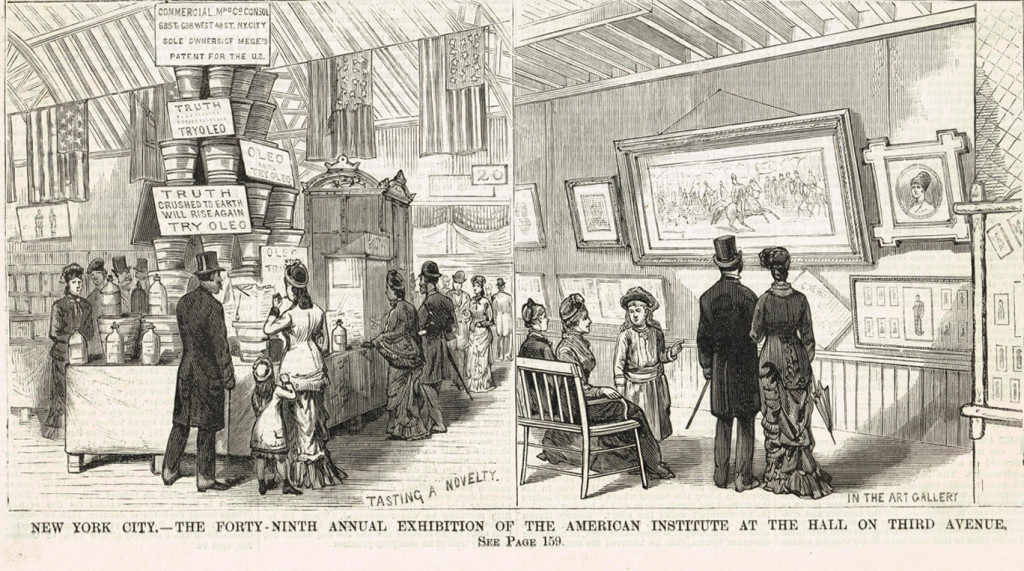
Exhibition at the American Institute Fair, New York City, 1880. Dare exhibited his toys and carriages at various exhibitions. Frank Leslie’s Illustrated Newspaper, November 1880. Barbara Williams collection
Aside from the initial 1863 advertisement, there doesn’t seem to be newspaper advertising for Dare’s toys, but he did display them at exhibitions, (later known as trade fairs), and was listed in their directories. In an 1874 directory of the American Horticulturist (merchants selling farm, garden, and household items), Dare’s product is doll furniture. In the 1876 Centennial Exhibition, a Dare carriage is on display. In 1877, in the American Agriculturist Directory it is boys’ wagons and portable writing desks.
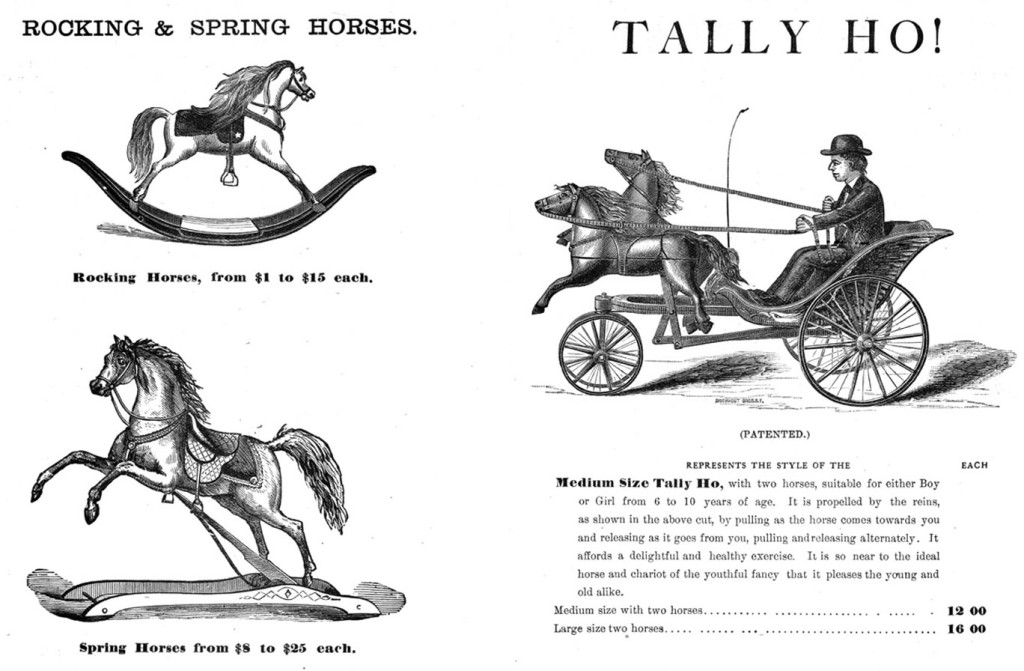
A page from an 1878 dated C.W.F. Dare toy catalog. Courtesy of the Strong National Museum of Play, Rochester, New York
What was possibly a boost to his business was his Tally Ho that may have debuted in 1878. The Centennial Commission awarded Dare medals for his children’s carriage exhibit and for his newly introduced Tally Ho, …”the most wonderful invention.” (25)
In its early existence the Dare firm wasn’t incorporated, rather, he was described as C. W. F. Dare, Manufacturer and Dealer or simply C.W.F. Dare. The C.W.F. Dare Company, which was incorporated, was formed in 1884. (24)
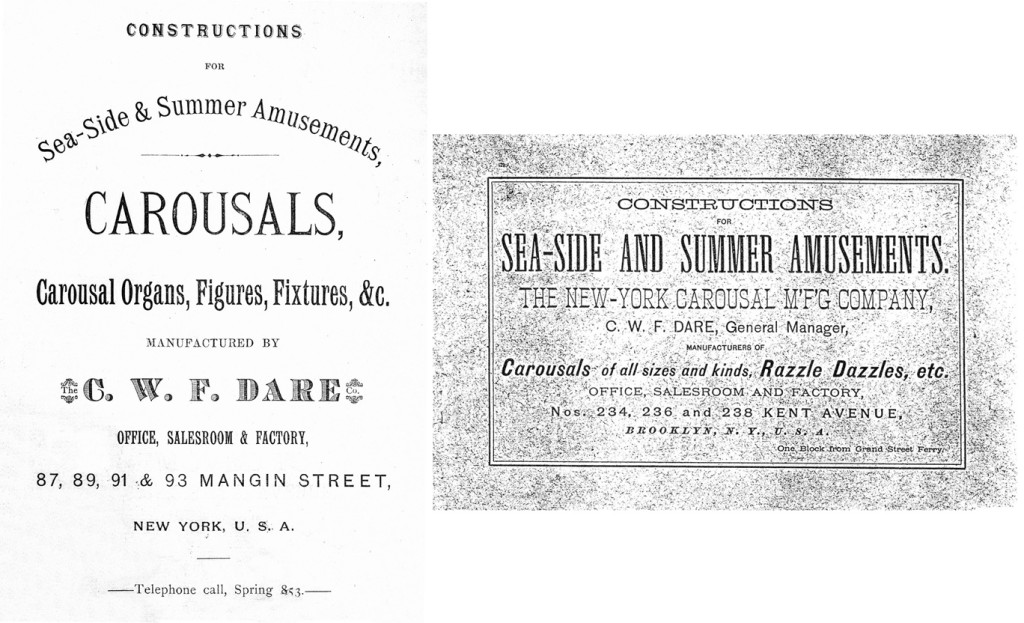
Left. The C.W.F. Dare Company catalog cover, circa 1884. Right. The cover of Dare’s circa 1890 The New-York Carousal M’F’G Company catalog. Fred and Mary Fried Archive, American History Museum, Smithsonian
The C.W.F. Dare Company – 1884 to 1887
The C.W.F. Dare Company was formed in 1884. As manager of the company, Dare received $25 a week in salary. (24) In the same year, the first descriptions of his carousel business in a newspaper article appeared – “Mr. Dare has the most exclusive manufacture of merry go rounds that are so popular he sends them to all parts of the world. (26) Dare carousels were said to have been sent to Mexico, Bogota, St. Thomas, Caracas, Amsterdam, Martinique, Paris, and Australia… “Indeed, there are more of them made for export than for home consumption“. (27) “He is a gentleman in the prime of his life… Personally, he is sociable…and attends to every wish of his patrons and by these qualifications has his present prosperous and successful business”. (28) These flattering remarks about Dare probably applied to his carousel business, which clearly began well before the incorporation based on the breadth described that year, and his on-going toy business.
As mentioned earlier, Dare’s businesses had periodic financial issues. In 1887, there was no doubt about his monetary woes. On October 5, 1887, Dare’s The C.W.F. Dare Company was found to be insolvent. An injunction imposed by the court ran from December 1, 1887 to January 23, 1888 during which time Dare was not allowed to do business. His property was seized and sold by the sheriff. There is a lengthy account of the New York Supreme Court Insolvency Hearing that was held in 1891 – 1892. (24) It details the finances, the individuals involved and the outcome. To summarize – The C.W.F Dare Company was drained financially by “kiting” – drawing on funds that were nonexistent by depositing checks and writing more checks against them before the original funds were in the accounts. Dare claimed it was his lumber supplier, who had access to the company bank accounts, who was to blame, having drawn $12,000 to $15,000 from the accounts. But, Dare must have had a role as, in shuffling things around, The C.W.F. Dare Company was sold to a middle man who hastily sold the company to Dare’s brother-in law, Abraham Folk, a blacksmith by trade and a seemingly uninvolved bystander. After the injunction was lifted, The C.W.F. Dare Company continued to operate with Folk as the “owner” until he sold the assets to the newly-formed New York Carousal Mfg. Company in January of 1890. The result of the Injunction Hearing – Abraham Folk was awarded $1,215.66 for losses.
Dare’s 1892 testimony (24) included interesting information about his business. He claimed to have started in the toy business in 1859. He did not solicit business (which explains limited advertising) – his customers came to him by mail or personally with their orders. At the time of the injunction, he claimed to have stock on hand of hobby horses, toy carriages, baby carriages, toy horses, sleighs, springing horses, velocipedes, Tally-Hos, boys’ propellers, girls’ propellers, tricycles, bicycles, toy washboards, wringers, toy racks for tables, and more.
With regard to his carousel business, Dare talked about his particular line of business (The C.W.F. Dare Company) of “manufacturing carousels” and how, in lamenting the loss of valued employees because of the injunction, “An ordinary carver can’t make a figure. You have to have a man who understands how to bring out the expression of a horse or a face.” Forty men were employed at the time of the injunction.
Dare said that manufacturing was primarily in the fall and winter for export business and in the spring and summer for local demand. Dare’s bookkeeper, Edwin F. Beebe, testified at the hearing. He said that The C.W.F. Dare Company got out of the toy business and went into the carousel business because it was a better business. His comments were not specific as to when exactly the toy business ended. In additional testimony, it was said that there were two salesmen for The C.W.F. Dare Company in 1887. They traveled to take orders and to make collections.

